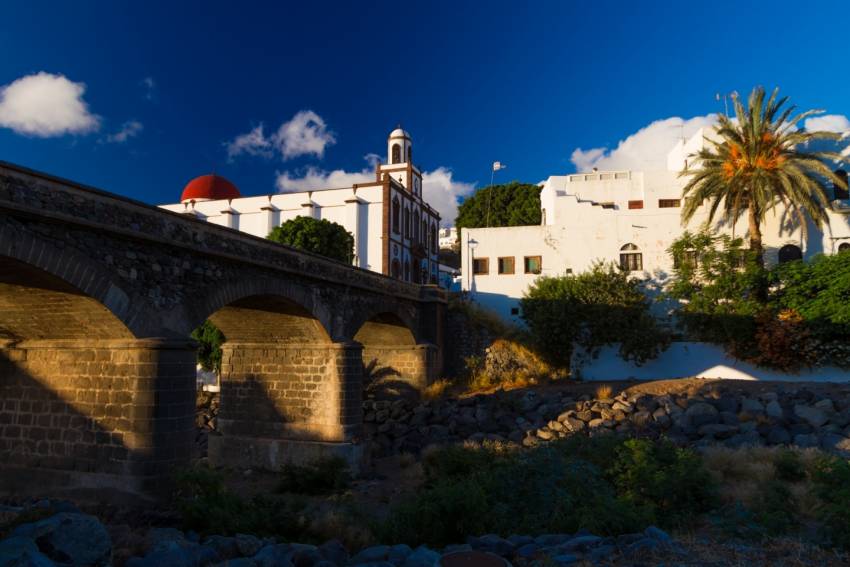The best ways to see Gran Canaria’s towns is by local bus or rental car. See our guide to getting about in Gran Canaria here.
Here's ten of the island's prettiest towns:
Teror
 Teror is the spiritual heart of Gran Canaria because its church is home to the island’s Patron Saint: La Virgen del Pino. With cobbled pedestrian streets, lots of typical wooden balconies, and a busy weekend market it’s a great town to visit. While Teror caters to tourists with souvenir shops, and restaurants with menus in English and German, it doesn’t look or feel touristy.
Teror is the spiritual heart of Gran Canaria because its church is home to the island’s Patron Saint: La Virgen del Pino. With cobbled pedestrian streets, lots of typical wooden balconies, and a busy weekend market it’s a great town to visit. While Teror caters to tourists with souvenir shops, and restaurants with menus in English and German, it doesn’t look or feel touristy.
The Virgen del Pino appeared miraculously in 1481 in a huge pine tree growing where the church stands now. The original church was built using the living tree to hold up the roof and unsurprisingly fell down. The huge baroque church that dominates the town today dates back to 1760.
You can visit the church any day and say hello to the island’s tree climbing guardian but please be quiet and respectful. Canarians never complain about bad behaviour from tourists but do get offended by insensitive behaviour. We’ve seen shirtless idiots in the church flashing away at pilgrims!
The cult of the Virgen del Pino spread with Canarian emigrants and she is a major Catholic figure all across South America. Canarians today make an annual pilgrimage to Teror during the first week of September to thank her for miracles and favours granted.
Lex Says: If you have a sore foot or a headache, then head to Teror on a Sunday. Look at the stalls to the right of the main church door and buy a wax effigy of the bit that hurts. Then take it into the church and offer it to the virgin. You’ll be cured instantly we promise.
Agaete/Puerto de Las Nieves
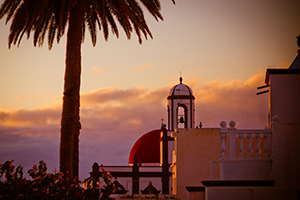 There isn’t much to do in whitewashed Agaete other than wander about its narrow streets and most tourists only stop for a few minutes before heading down to Puerto de las Nieves for lunch. This suits the locals perfectly as the town’s unofficial motto is “come, see and go away again”. Agaete is happy for tourists to visit but guards its traditions and Canarian lifestyle carefully.
There isn’t much to do in whitewashed Agaete other than wander about its narrow streets and most tourists only stop for a few minutes before heading down to Puerto de las Nieves for lunch. This suits the locals perfectly as the town’s unofficial motto is “come, see and go away again”. Agaete is happy for tourists to visit but guards its traditions and Canarian lifestyle carefully.
The Agaete Valley behind the town is one of the island’s best. It’s green and fertile and full of old Canarian houses, terraced fields and palm trees. The road end at the top of the valley but the trip is worthwhile for the great views.
Do a 2,5h tour in english with a young inspiring and enthusiastic local, learn all about this beautiful village and pay as much as you like. Good deal? We certainly think so!
Agaete comes alive every year for the Bajada de la Rama festival on August 4. It’s a huge and spectacular fiesta with about 50,000 people crammed into the square and narrow streets. In the morning everybody troops down the hill carrying branches. After a long pause for beer, rum and lunch, the procession continues towards the sea at Puerto de las Nieves. Here everybody beats the sea to appease the ancient goddess of rain. The tradition dates back to pre-Hispanic times.
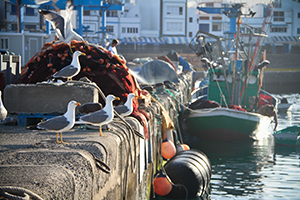 Puerto de las Nieves is Gran Canaria’s most attractive seaside town with whitewashed houses, blue window frames and a great pebble beach. Sadly its famous Finger of God Rock collapsed during Tropical Storm Delta in 2005. The lack of a deity’s finger doesn’t make the town any less attractive and you can still see the knuckle by looking towards the cliffs from the old jetty.
Puerto de las Nieves is Gran Canaria’s most attractive seaside town with whitewashed houses, blue window frames and a great pebble beach. Sadly its famous Finger of God Rock collapsed during Tropical Storm Delta in 2005. The lack of a deity’s finger doesn’t make the town any less attractive and you can still see the knuckle by looking towards the cliffs from the old jetty.
Canarians head to Puerto de las Nieves at weekends for seafood on the beachfront. The fresh fish and squid is excellent and the whole town smells of lemon juice and fried calamares.
Alex Says: Agaete is Lex’s local town. You’ll find him in the square most Friday evenings nattering to his friends over a few rum and cokes. Feel free to buy him a drink but please respect his local reputation and don’t ask for a photo.
Fataga
 Fataga is about half an hour’s drive from Playa del Inglés up a winding road. It’s a ridiculously pretty little town with palm trees, fruit trees and tiled rooves wherever you look. Fataga is also one of the oldest habitations on the island as the modern village sits on top of an old Guanche settlement.
Fataga is about half an hour’s drive from Playa del Inglés up a winding road. It’s a ridiculously pretty little town with palm trees, fruit trees and tiled rooves wherever you look. Fataga is also one of the oldest habitations on the island as the modern village sits on top of an old Guanche settlement.
As you drive towards Fataga up the valley stop at the Degollada de las Yeguas mirador for stunning views of the valley and the Cumbres. Further on you get a view of the Guanche cemetery and the town’s famous palm grove (regenerating nicely after a vicious fire in 2007). If the snack and juice van is open, get a papaya and orange smoothie: They’re excellent.
Fataga attracts artists and the souvenir shops sell local art and crafts that are a cut above the plastic bulls and garish tea towels in the resorts. Look out for galleries selling art by German resident Friedhelm Berghorn and local sculptor Luis Montull.
La Aldea de San Nicolas
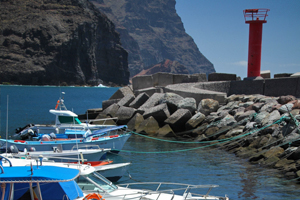 You couldn’t get to La Aldea by road until the 1960s and it’s still quicker to get to Tenerife by ferry than it is to drive to La Aldea. The spectacular roads in are well worth the trip as the scenery is fantastic, especially along the west coast road from Agaete.
You couldn’t get to La Aldea by road until the 1960s and it’s still quicker to get to Tenerife by ferry than it is to drive to La Aldea. The spectacular roads in are well worth the trip as the scenery is fantastic, especially along the west coast road from Agaete.
La Aldea is famous for Gran Canaria’s biggest and craziest romeria. On September 10 thousands of people run into the lagoon at La Aldea to catch fish: The one who gets the most becomes king or queen of the festival. Many wear traditional costume during the hunt because the island bishop once said that wearing shorts was a sin.
La Aldea has some great fish restaurants down by its pebble beach. For the best bit of beach go through the tunnel just to the north of the restaurants. Ask in the harbour if you want to get to Guigui Beach from La Aldea. If the sea is calm there is often a fisherman who will drop you off and, just as importantly, pick you up again.
Lex Says: Not much happens at La Aldea apart from a lot of tomato growing: It’s greenhouses are so large that they have their own beehives and look like lakes when viewed from the top of the island. Oh yes, and there's the annual crazy party!
Galdar
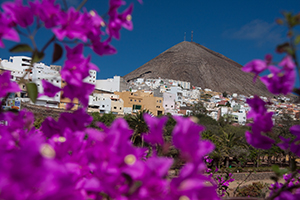 Galdar was one of the two Canarii capitals of Gran Canaria and its Cueva Pintada archaeological park is the best place to visit Canarii ruins on the island. Galdar also has a pretty historical centre and church, and the gnarliest surf wave in Europe at El Fronton on the coast.
Galdar was one of the two Canarii capitals of Gran Canaria and its Cueva Pintada archaeological park is the best place to visit Canarii ruins on the island. Galdar also has a pretty historical centre and church, and the gnarliest surf wave in Europe at El Fronton on the coast.
Modern Galdar is an epic tribute to human optimism as it has sprawled up the side of a volcanic peak that is still geologically active. While it hasn’t erupted for thousands of years it could come back to life tomorrow. In the meantime it’s worth the steep hike up the top to see the banana plantations and rugged coastline stretching away into the distance. Sunsets from the top are spectacular.
The Cueva Pintada is an excavated Canarii town (village) with a cave decorated with coloured squares and triangles as the main highlight. There is a replica of the cave in the Museo Canario in Las Palmas if you don’t make it to Galdar. The park opens Tuesday to Saturday from 09.30. Entry costs six euros.
It’s unfair to mention Galdar without giving next-door Guía its due. The two towns basically merge but Guía has its own cobbled heart and is where Flor de Guía Cheese is made. Flor de Guía is a delicious white cheese that is suitable for vegetarians: Thistle juice is used instead of rennet to curdle the milk.
Lex Says: Don’t miss the old dragon tree in the Tourist Information Office on the main square in Galdar. It was there in 1718.
Tejeda
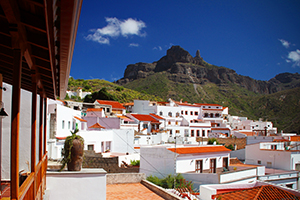 Tejeda vies with Teror as Gran Canaria’s prettiest and most typically Canarian town. It is exceptionally pretty with neat white houses, red tile rooves and spectacular views of the centre of Gran Canaria. At 1,050 metres above sea level the town glows in the strong sun.
Tejeda vies with Teror as Gran Canaria’s prettiest and most typically Canarian town. It is exceptionally pretty with neat white houses, red tile rooves and spectacular views of the centre of Gran Canaria. At 1,050 metres above sea level the town glows in the strong sun.
Tejeda is famous in Gran Canaria for the quality of the fruit and vegetables from its terraced farms, especially potatoes and oranges, Today its main source of income is tourists and local visitors and Tejeda’s restaurants serve excellent local food on terraces with superb views.
Alex Says: There was a crazy plan to link Tejeda to Roque Nublo with a cable car. Most people hated the idea and it seems to be on the back burner.
Santa Lucia
 Santa Lucia is the prettiest hill town in the south east of Gran Canaria. It’s a sleepy place surrounded by palm trees fruit orchards and olive trees. Apart for a couple of local shops and restaurants there isn’t much to do except potter about and enjoy the views.
Santa Lucia is the prettiest hill town in the south east of Gran Canaria. It’s a sleepy place surrounded by palm trees fruit orchards and olive trees. Apart for a couple of local shops and restaurants there isn’t much to do except potter about and enjoy the views.
Just outside town in the improbable but fascinating castle/museum called the Castillo de la Fortaleza (you can’t miss it). It’s collection of agricultural tools, artillery and Canarii artefacts are worth a stop. Nearby is the Fortaleza Grande, a rock bluff that sticks out from the barranco floor. It was the site of one of the last battles between the Spanish and the Canarii. Legend has it that the last Canarii warriors threw themselves from the rock rather than surrender.
Santa Lucia’s main romeria is on December 13. People from all over Gran Canaria gather in the town in traditional dress to watch processions and drink mejunje liqueur, made from rum, honey, cinnamon and lemon verbena herb.
Alex Says: Try the mejunje but in moderation: It’s tasty stuff but real hangover juice!
Agüimes
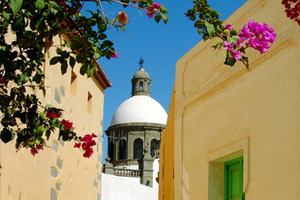 The east coast plain of Gran Canaria isn’t the prettiest part of the island. It’s flat, dry and windy and difficult to love unless you are a windsurfer. However, Agüimes is among the island’s best rural towns and is just 15 minutes drive inland from the GC1 motorway.
The east coast plain of Gran Canaria isn’t the prettiest part of the island. It’s flat, dry and windy and difficult to love unless you are a windsurfer. However, Agüimes is among the island’s best rural towns and is just 15 minutes drive inland from the GC1 motorway.
Agüimes is dominated by its colossal San Sebastián church but the whole historical district is perfectly preserved and decorated with bronze sculptures of notable Canarians. There are some great restaurants in the back streets, including Los Camellos; run by the island’s cookery institute. Agüimes was home to noted Canarian sculptor Luján Perez and examples of his realistic religious works decorate the church interior.
Agüimes is also the closest town to immense Guayadeque ravine with its sheer sides and cave houses and restaurants. If you want to see Gran Canaria’s spectacular scenery but don’t fancy its mountain roads, then head here. The road winds up the valley floor and has no steep drops or blue-sky curves!
Arucas
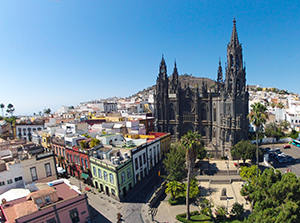 The imposing, some might say disproportionate, church of San Juan Bautista dominates the Arucas skyline. It’s a dark, gothic masterpiece made from local stone at the beginning of the 20th Century and was funded by the massive profits from local cochineal farming. Surrounded by a surprisingly green historic district, the church makes Arucas a great stop on an island tour. Its old centre is on a larger scale than most of the island’s old towns and feels rather grand.
The imposing, some might say disproportionate, church of San Juan Bautista dominates the Arucas skyline. It’s a dark, gothic masterpiece made from local stone at the beginning of the 20th Century and was funded by the massive profits from local cochineal farming. Surrounded by a surprisingly green historic district, the church makes Arucas a great stop on an island tour. Its old centre is on a larger scale than most of the island’s old towns and feels rather grand.
Arucas also makes the vast majority of Gran Canaria’s rum: A tipple the island has an unquenchable thirst for. You can visit the distillery during the week and sample the dozens of rums and liqueurs that it makes.
Alex Says: At the Arehucas distillery, head straight for the aged rum samples rather than the sweet liqueurs. You’ll get less of a hangover!
Temisas
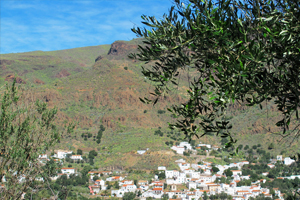 Temisas is between Agüimes and Santa Lucia and makes the Top Ten thanks to its olive trees. Long neglected they have now been pruned and fertilized and produce delicious black olives and quality olive oil. Temisas is a small town but almost all of its houses are original and you can still see the remains of the island’s oldest olive press.
Temisas is between Agüimes and Santa Lucia and makes the Top Ten thanks to its olive trees. Long neglected they have now been pruned and fertilized and produce delicious black olives and quality olive oil. Temisas is a small town but almost all of its houses are original and you can still see the remains of the island’s oldest olive press.
The surrounding area is covered in terraces with fringes of old, twisted olive trees.
Lex Says: To buy delicious Temisas olive oil ask in the shops and bars along the road through the town.


